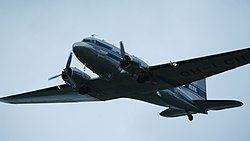Passengers 8 Date 18 November 1946 Number of deaths 0 Passenger count 8 | Registration 42-68846 Survivor 12 Crew count 4 | |
 | ||
Summary Weather related Controlled Flight Into Terrain Aircraft type Douglas C-53D Skytrooper Similar 1946 Railway Air Services, 1946 Antarctica PBM Mari, British European Airways F, 1946 American Overseas, TWA Flight 6963 | ||
The C-53 Crash on the Gauli Glacier in the Bernese Alps, (Switzerland) on 19 November 1946 was a turning point in alpine rescue and an international media event. The aircraft, coming from Tulln, Austria (near Vienna), bound for Pisa, Italy, collided with the Gauli Glacier in poor visibility. On board were eight passengers (among them two high-ranking officers of the U.S. armed forces, four women and one 11-year-old girl) and four crew. Several people were injured, but there were no fatalities.
Contents
Flight
On 18 November 1946 the C-53 Skytrooper military transport aircraft, (serial no. 42-68846) – a military, passenger-only, variant of the civilian Douglas DC-3 airliner – took off from Tulln Air Base near Vienna, Austria, bound for Pisa, Italy. The route planning was affected by bad weather, so they chose a route (950 km) via Munich, Strasbourg, Dijon and Marseille-Istres, to arrive in Pisa two days later.
Having already avoided several alpine peaks in instrument meteorological conditions, near Innsbruck, the crew became disoriented, and on 18 November at 2.45 PM, the aircraft crash-landed on the Gauli Glacier with a speed of 174 mph (280 km/h) at an altitude of 10,990 ft (3,350 m) because of the sudden onset of a Katabatic wind, the aircraft sliding over ice and snow upwards, slowing down rapidly.
Search
The crew thought the aircraft had crashed in the French Alps. An hour after the crash, the crew was able to send emergency radio messages which were received at Orly Airport and at the Istres-Le Tubé Air Base near Marseille, tri-angulating their position in the Airolo-Sion-Jungfrau triangle. A large search and rescue operation began immediately.
Two days later, the control tower at Swiss Air Force Base Meiringen, 12.7 km (8 mi) away, received their radio calls, giving a new radio bearing, narrowing the search area to the Gauli Glacier.
At 0931 hours on 22 November an RAF Lancaster, piloted by F/L G. Head, spotted the aircraft through a break in the cloud cover. The crew managed to plot the location by using radio plots. Later that day when the clouds cleared, search aircraft were sent to this location.
A Boeing B-29 Superfortress sighted the aircraft by chance from an altitude of 16,000 ft (5 km) whilst en route to Munich, later confirmed by the crew of a Swiss Air Force (SwAF) EKW C-36.
Rescue
After the accident location was known, a large alpine rescue operation was initiated. The United States Army (US Army) arrived with a train carrying equipment in Interlaken, where the normal gauge railway track ends. The U.S. response units were equipped with Willys MB jeeps and snowcats (some accounts describe the "snowcats" as being the amphibious-hulled versions of the American M29 Weasel tracked vehicles) but these were potentially useless in the alpine conditions (despite their intended design for wintertime use). The potentially cumbersome use of military gliders was contemplated but was not considered further, so rescue teams had to proceed on foot.
On 23 November at 2:20 PM, two Swiss soldiers on ski reached the stricken aircraft and its passengers after a 13-hour ascent from Innertkirchen, but as it was too late for a descent on the same day, it was decided to wait at the wreck over night, enduring temperatures of 5 °F (−15 °C). The next day, everybody descended towards the Alpine Club's Gauli hut at 7,234 ft (2,205 m), failing to make radio contact with the coordinators in the valley. At 10.20 AM, SwAF pilots, Captain Victor Hug and Major Pista Hitz, managed to land two Fieseler Storch aircraft on the glacier beside the rescuers, and with eight flights, everybody was flown to safety. The Swiss army had tested snow landings and starts during winter 1944/45.
Aftermath
After World War II, the diplomatic relationships between Switzerland and the United States were uncertain, but after the successful rescue, the political climate improved – also because the rescue work was prominently covered by the international media.
The rescue action lingered on years later, when the Swiss were called to support the rescue and salvage after the 1956 Grand Canyon mid-air collision.
Beside that, the rescue of the aircraft occupants in alpine terrain made a virtue out of necessity. The crash on the Gauli glacier is viewed as the birth of Swiss air rescue, and in 1952, the Swiss Air Rescue Guard was founded.
